Nursing Case Study: Hyperthyroidism, Diagnosis, and Treatment
VerifiedAdded on 2020/04/15
|8
|1489
|699
Case Study
AI Summary
This nursing case study delves into Graves' disease and hyperthyroidism, exploring the underlying mechanisms of these autoimmune conditions. It examines the role of auto-antibodies, particularly long-acting thyroid-stimulating (LATS) antibodies, in over-producing thyroid hormones, leading to hyperthyroidism. The study analyzes a patient's blood reports, highlighting the abnormal levels of T3 and T4 hormones and their correlation with the disease. It also touches upon the digestive and immune systems, rheumatoid arthritis, and the treatment options, including surgical removal of the thyroid gland and hormone replacement therapy. References to relevant research papers are included, providing a comprehensive overview of the topic.
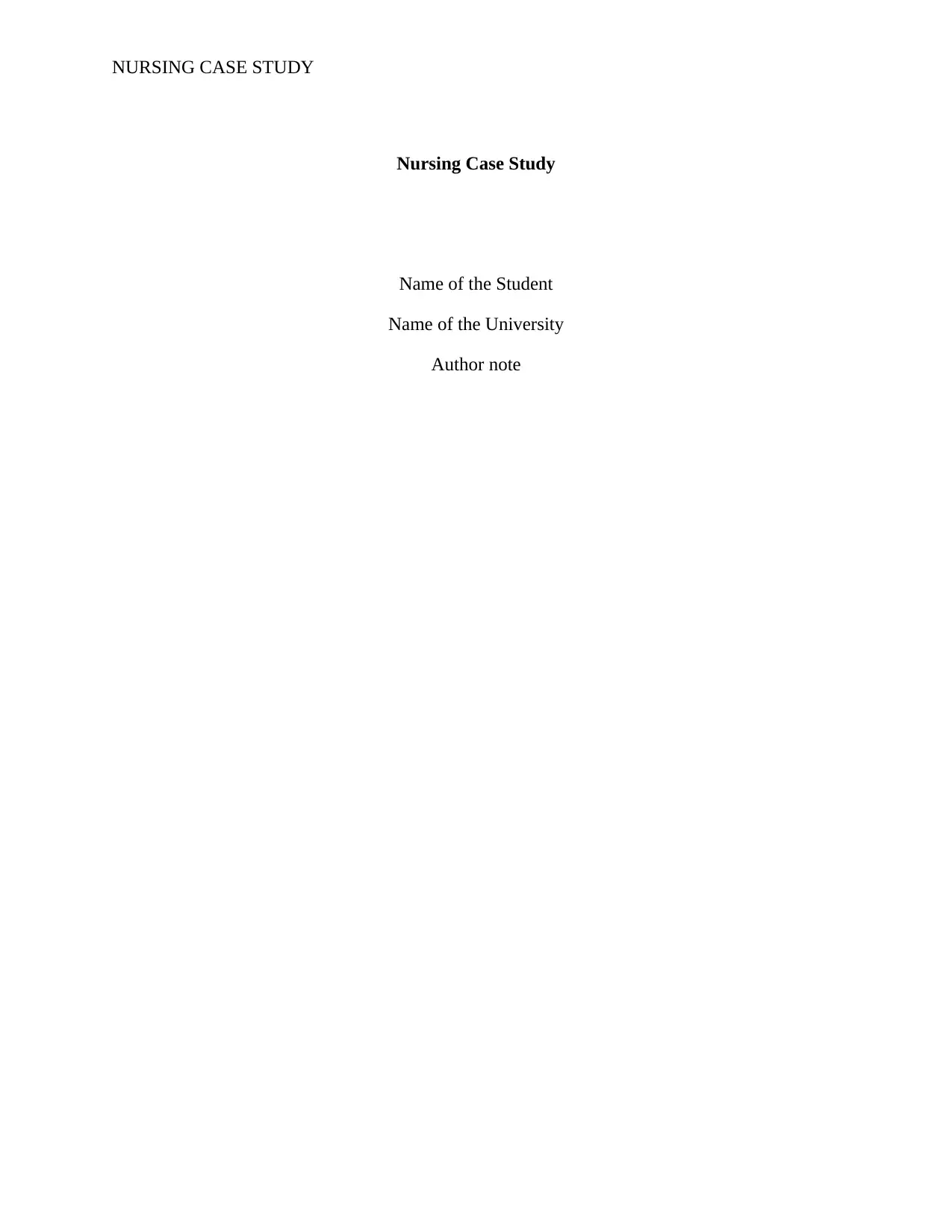
NURSING CASE STUDY
Nursing Case Study
Name of the Student
Name of the University
Author note
Nursing Case Study
Name of the Student
Name of the University
Author note
Paraphrase This Document
Need a fresh take? Get an instant paraphrase of this document with our AI Paraphraser
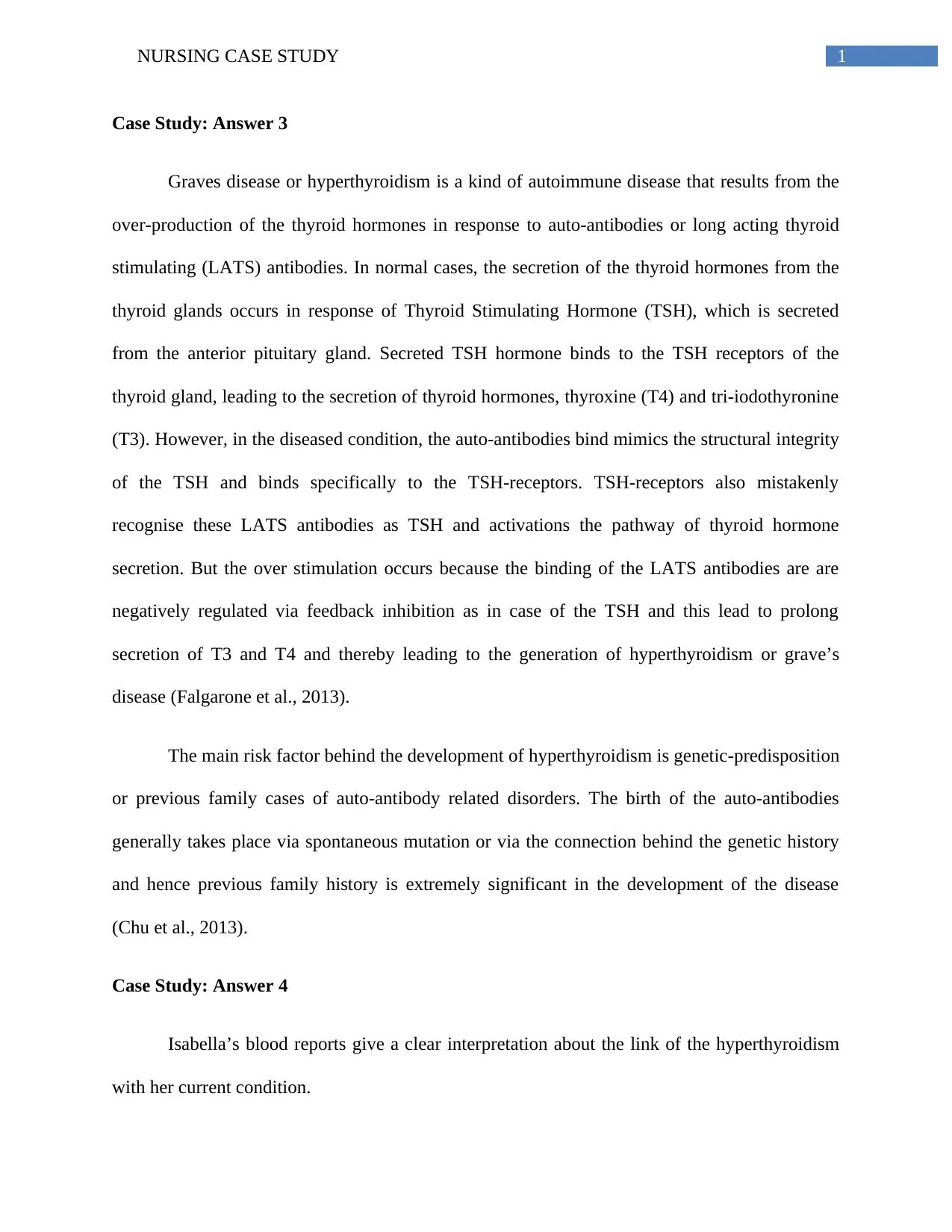
1NURSING CASE STUDY
Case Study: Answer 3
Graves disease or hyperthyroidism is a kind of autoimmune disease that results from the
over-production of the thyroid hormones in response to auto-antibodies or long acting thyroid
stimulating (LATS) antibodies. In normal cases, the secretion of the thyroid hormones from the
thyroid glands occurs in response of Thyroid Stimulating Hormone (TSH), which is secreted
from the anterior pituitary gland. Secreted TSH hormone binds to the TSH receptors of the
thyroid gland, leading to the secretion of thyroid hormones, thyroxine (T4) and tri-iodothyronine
(T3). However, in the diseased condition, the auto-antibodies bind mimics the structural integrity
of the TSH and binds specifically to the TSH-receptors. TSH-receptors also mistakenly
recognise these LATS antibodies as TSH and activations the pathway of thyroid hormone
secretion. But the over stimulation occurs because the binding of the LATS antibodies are are
negatively regulated via feedback inhibition as in case of the TSH and this lead to prolong
secretion of T3 and T4 and thereby leading to the generation of hyperthyroidism or grave’s
disease (Falgarone et al., 2013).
The main risk factor behind the development of hyperthyroidism is genetic-predisposition
or previous family cases of auto-antibody related disorders. The birth of the auto-antibodies
generally takes place via spontaneous mutation or via the connection behind the genetic history
and hence previous family history is extremely significant in the development of the disease
(Chu et al., 2013).
Case Study: Answer 4
Isabella’s blood reports give a clear interpretation about the link of the hyperthyroidism
with her current condition.
Case Study: Answer 3
Graves disease or hyperthyroidism is a kind of autoimmune disease that results from the
over-production of the thyroid hormones in response to auto-antibodies or long acting thyroid
stimulating (LATS) antibodies. In normal cases, the secretion of the thyroid hormones from the
thyroid glands occurs in response of Thyroid Stimulating Hormone (TSH), which is secreted
from the anterior pituitary gland. Secreted TSH hormone binds to the TSH receptors of the
thyroid gland, leading to the secretion of thyroid hormones, thyroxine (T4) and tri-iodothyronine
(T3). However, in the diseased condition, the auto-antibodies bind mimics the structural integrity
of the TSH and binds specifically to the TSH-receptors. TSH-receptors also mistakenly
recognise these LATS antibodies as TSH and activations the pathway of thyroid hormone
secretion. But the over stimulation occurs because the binding of the LATS antibodies are are
negatively regulated via feedback inhibition as in case of the TSH and this lead to prolong
secretion of T3 and T4 and thereby leading to the generation of hyperthyroidism or grave’s
disease (Falgarone et al., 2013).
The main risk factor behind the development of hyperthyroidism is genetic-predisposition
or previous family cases of auto-antibody related disorders. The birth of the auto-antibodies
generally takes place via spontaneous mutation or via the connection behind the genetic history
and hence previous family history is extremely significant in the development of the disease
(Chu et al., 2013).
Case Study: Answer 4
Isabella’s blood reports give a clear interpretation about the link of the hyperthyroidism
with her current condition.
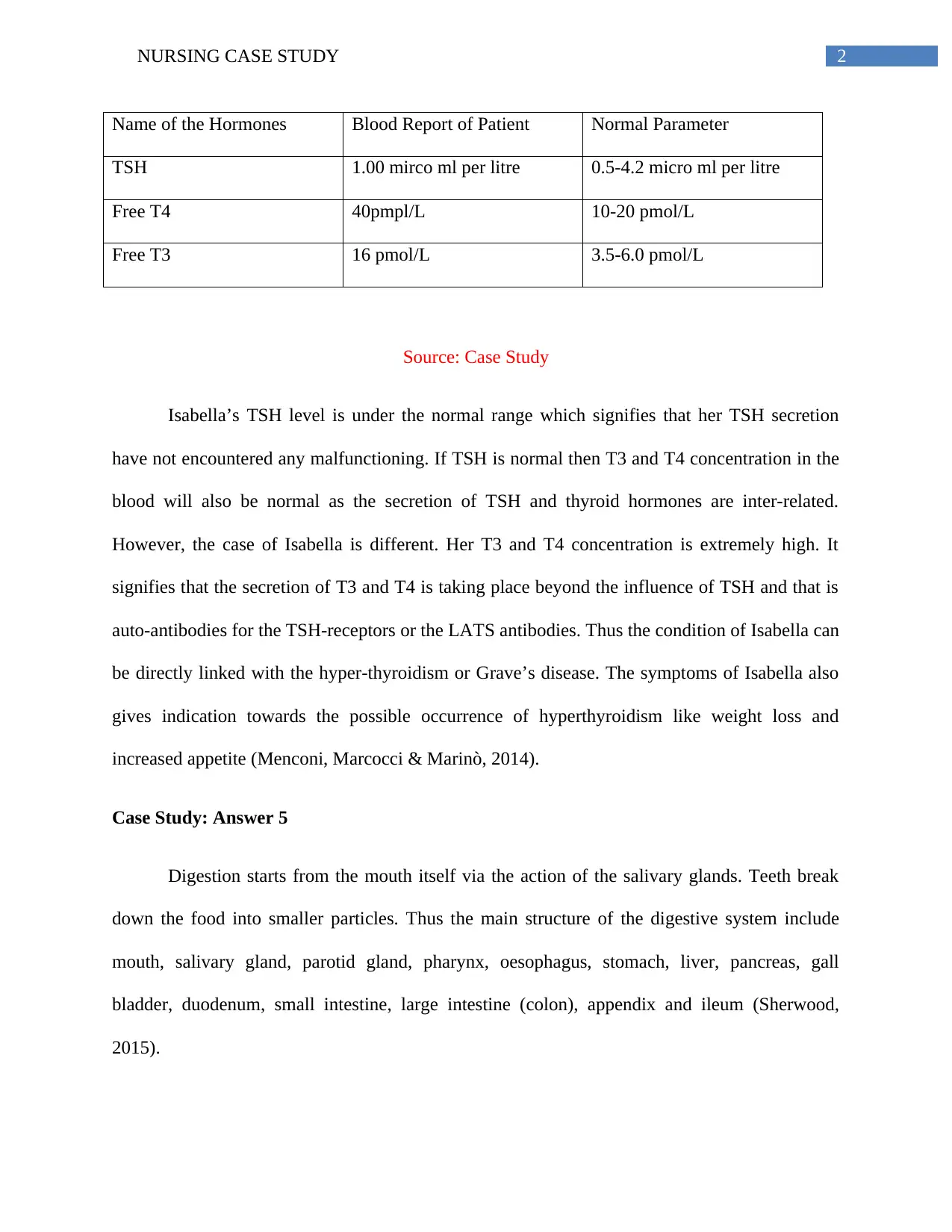
2NURSING CASE STUDY
Name of the Hormones Blood Report of Patient Normal Parameter
TSH 1.00 mirco ml per litre 0.5-4.2 micro ml per litre
Free T4 40pmpl/L 10-20 pmol/L
Free T3 16 pmol/L 3.5-6.0 pmol/L
Source: Case Study
Isabella’s TSH level is under the normal range which signifies that her TSH secretion
have not encountered any malfunctioning. If TSH is normal then T3 and T4 concentration in the
blood will also be normal as the secretion of TSH and thyroid hormones are inter-related.
However, the case of Isabella is different. Her T3 and T4 concentration is extremely high. It
signifies that the secretion of T3 and T4 is taking place beyond the influence of TSH and that is
auto-antibodies for the TSH-receptors or the LATS antibodies. Thus the condition of Isabella can
be directly linked with the hyper-thyroidism or Grave’s disease. The symptoms of Isabella also
gives indication towards the possible occurrence of hyperthyroidism like weight loss and
increased appetite (Menconi, Marcocci & Marinò, 2014).
Case Study: Answer 5
Digestion starts from the mouth itself via the action of the salivary glands. Teeth break
down the food into smaller particles. Thus the main structure of the digestive system include
mouth, salivary gland, parotid gland, pharynx, oesophagus, stomach, liver, pancreas, gall
bladder, duodenum, small intestine, large intestine (colon), appendix and ileum (Sherwood,
2015).
Name of the Hormones Blood Report of Patient Normal Parameter
TSH 1.00 mirco ml per litre 0.5-4.2 micro ml per litre
Free T4 40pmpl/L 10-20 pmol/L
Free T3 16 pmol/L 3.5-6.0 pmol/L
Source: Case Study
Isabella’s TSH level is under the normal range which signifies that her TSH secretion
have not encountered any malfunctioning. If TSH is normal then T3 and T4 concentration in the
blood will also be normal as the secretion of TSH and thyroid hormones are inter-related.
However, the case of Isabella is different. Her T3 and T4 concentration is extremely high. It
signifies that the secretion of T3 and T4 is taking place beyond the influence of TSH and that is
auto-antibodies for the TSH-receptors or the LATS antibodies. Thus the condition of Isabella can
be directly linked with the hyper-thyroidism or Grave’s disease. The symptoms of Isabella also
gives indication towards the possible occurrence of hyperthyroidism like weight loss and
increased appetite (Menconi, Marcocci & Marinò, 2014).
Case Study: Answer 5
Digestion starts from the mouth itself via the action of the salivary glands. Teeth break
down the food into smaller particles. Thus the main structure of the digestive system include
mouth, salivary gland, parotid gland, pharynx, oesophagus, stomach, liver, pancreas, gall
bladder, duodenum, small intestine, large intestine (colon), appendix and ileum (Sherwood,
2015).
⊘ This is a preview!⊘
Do you want full access?
Subscribe today to unlock all pages.

Trusted by 1+ million students worldwide
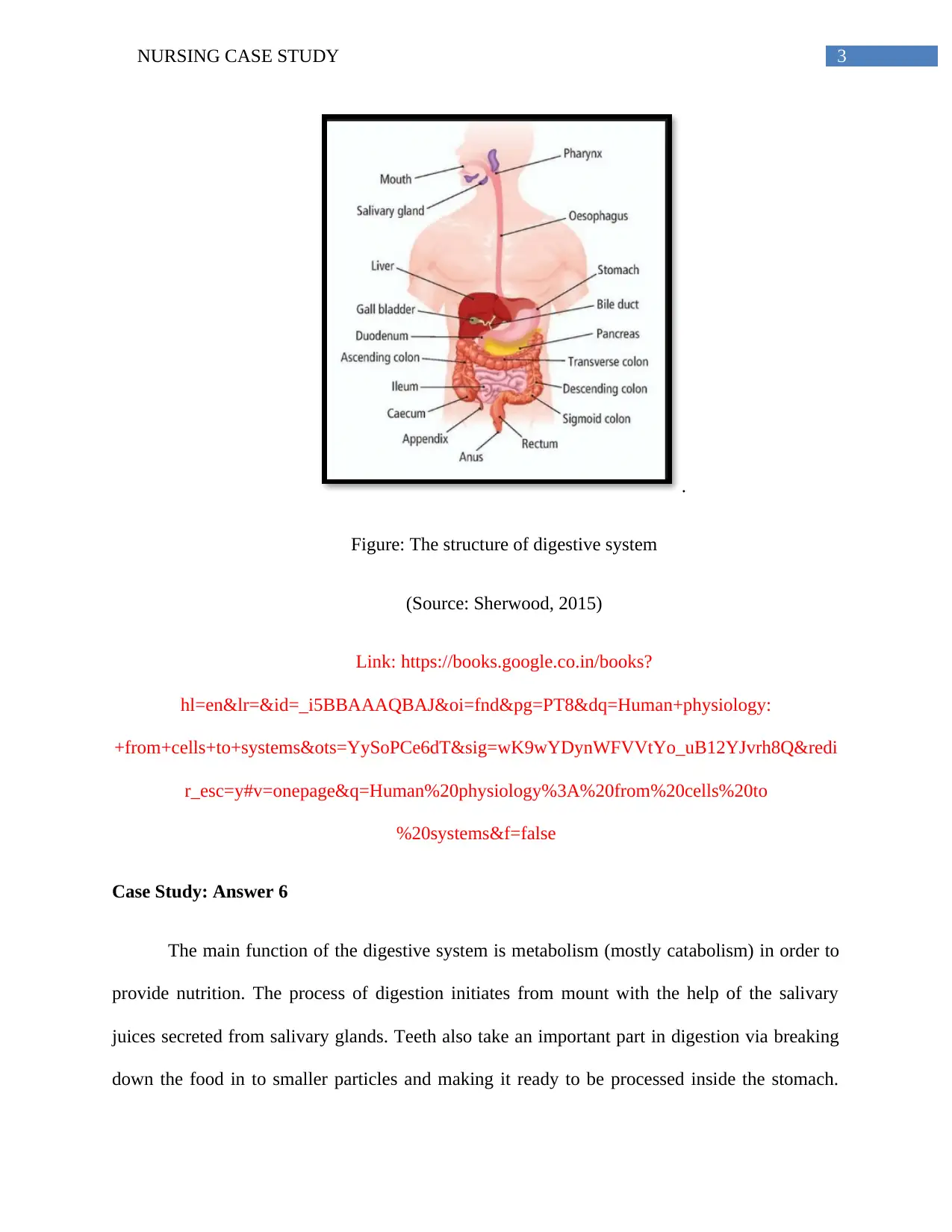
3NURSING CASE STUDY
.
Figure: The structure of digestive system
(Source: Sherwood, 2015)
Link: https://books.google.co.in/books?
hl=en&lr=&id=_i5BBAAAQBAJ&oi=fnd&pg=PT8&dq=Human+physiology:
+from+cells+to+systems&ots=YySoPCe6dT&sig=wK9wYDynWFVVtYo_uB12YJvrh8Q&redi
r_esc=y#v=onepage&q=Human%20physiology%3A%20from%20cells%20to
%20systems&f=false
Case Study: Answer 6
The main function of the digestive system is metabolism (mostly catabolism) in order to
provide nutrition. The process of digestion initiates from mount with the help of the salivary
juices secreted from salivary glands. Teeth also take an important part in digestion via breaking
down the food in to smaller particles and making it ready to be processed inside the stomach.
.
Figure: The structure of digestive system
(Source: Sherwood, 2015)
Link: https://books.google.co.in/books?
hl=en&lr=&id=_i5BBAAAQBAJ&oi=fnd&pg=PT8&dq=Human+physiology:
+from+cells+to+systems&ots=YySoPCe6dT&sig=wK9wYDynWFVVtYo_uB12YJvrh8Q&redi
r_esc=y#v=onepage&q=Human%20physiology%3A%20from%20cells%20to
%20systems&f=false
Case Study: Answer 6
The main function of the digestive system is metabolism (mostly catabolism) in order to
provide nutrition. The process of digestion initiates from mount with the help of the salivary
juices secreted from salivary glands. Teeth also take an important part in digestion via breaking
down the food in to smaller particles and making it ready to be processed inside the stomach.
Paraphrase This Document
Need a fresh take? Get an instant paraphrase of this document with our AI Paraphraser
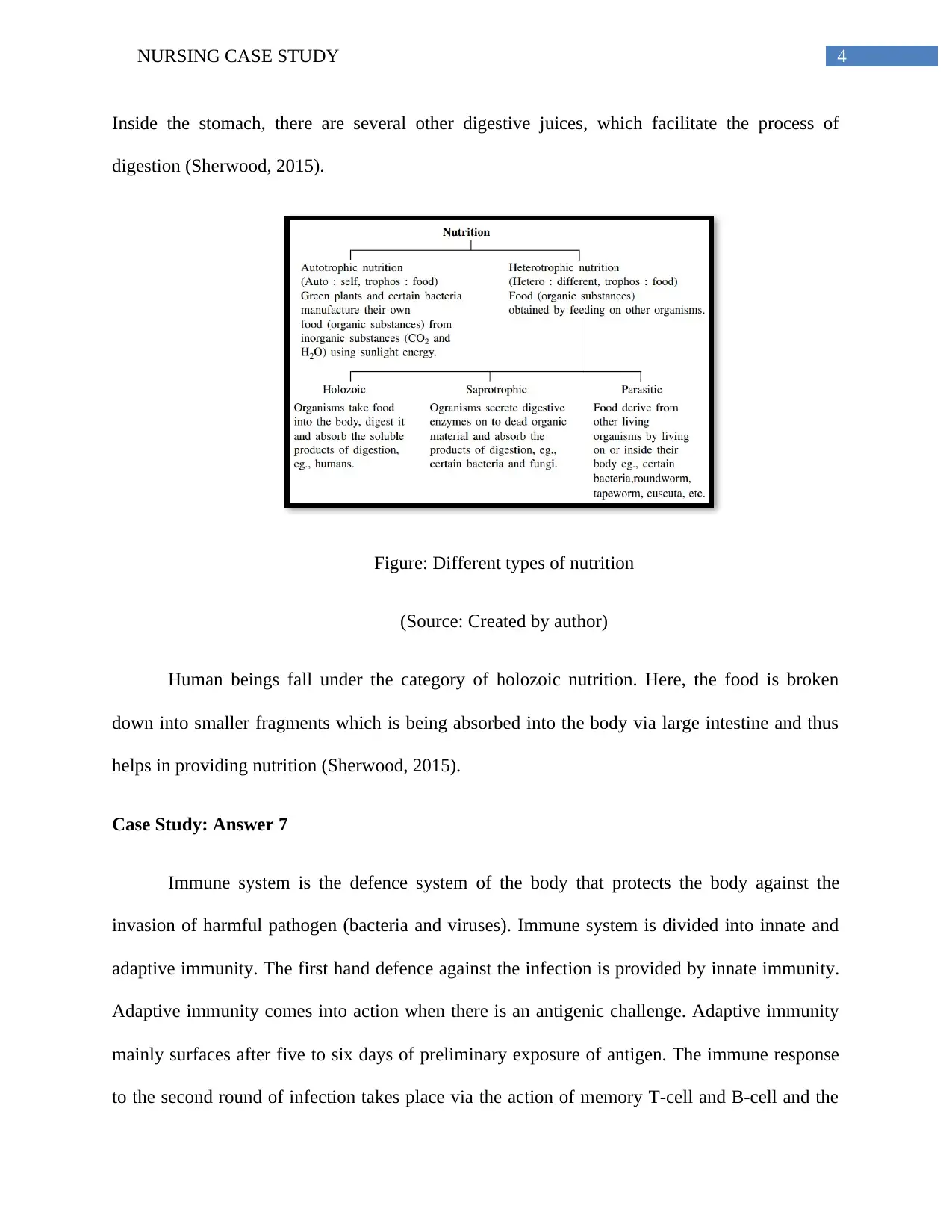
4NURSING CASE STUDY
Inside the stomach, there are several other digestive juices, which facilitate the process of
digestion (Sherwood, 2015).
Figure: Different types of nutrition
(Source: Created by author)
Human beings fall under the category of holozoic nutrition. Here, the food is broken
down into smaller fragments which is being absorbed into the body via large intestine and thus
helps in providing nutrition (Sherwood, 2015).
Case Study: Answer 7
Immune system is the defence system of the body that protects the body against the
invasion of harmful pathogen (bacteria and viruses). Immune system is divided into innate and
adaptive immunity. The first hand defence against the infection is provided by innate immunity.
Adaptive immunity comes into action when there is an antigenic challenge. Adaptive immunity
mainly surfaces after five to six days of preliminary exposure of antigen. The immune response
to the second round of infection takes place via the action of memory T-cell and B-cell and the
Inside the stomach, there are several other digestive juices, which facilitate the process of
digestion (Sherwood, 2015).
Figure: Different types of nutrition
(Source: Created by author)
Human beings fall under the category of holozoic nutrition. Here, the food is broken
down into smaller fragments which is being absorbed into the body via large intestine and thus
helps in providing nutrition (Sherwood, 2015).
Case Study: Answer 7
Immune system is the defence system of the body that protects the body against the
invasion of harmful pathogen (bacteria and viruses). Immune system is divided into innate and
adaptive immunity. The first hand defence against the infection is provided by innate immunity.
Adaptive immunity comes into action when there is an antigenic challenge. Adaptive immunity
mainly surfaces after five to six days of preliminary exposure of antigen. The immune response
to the second round of infection takes place via the action of memory T-cell and B-cell and the
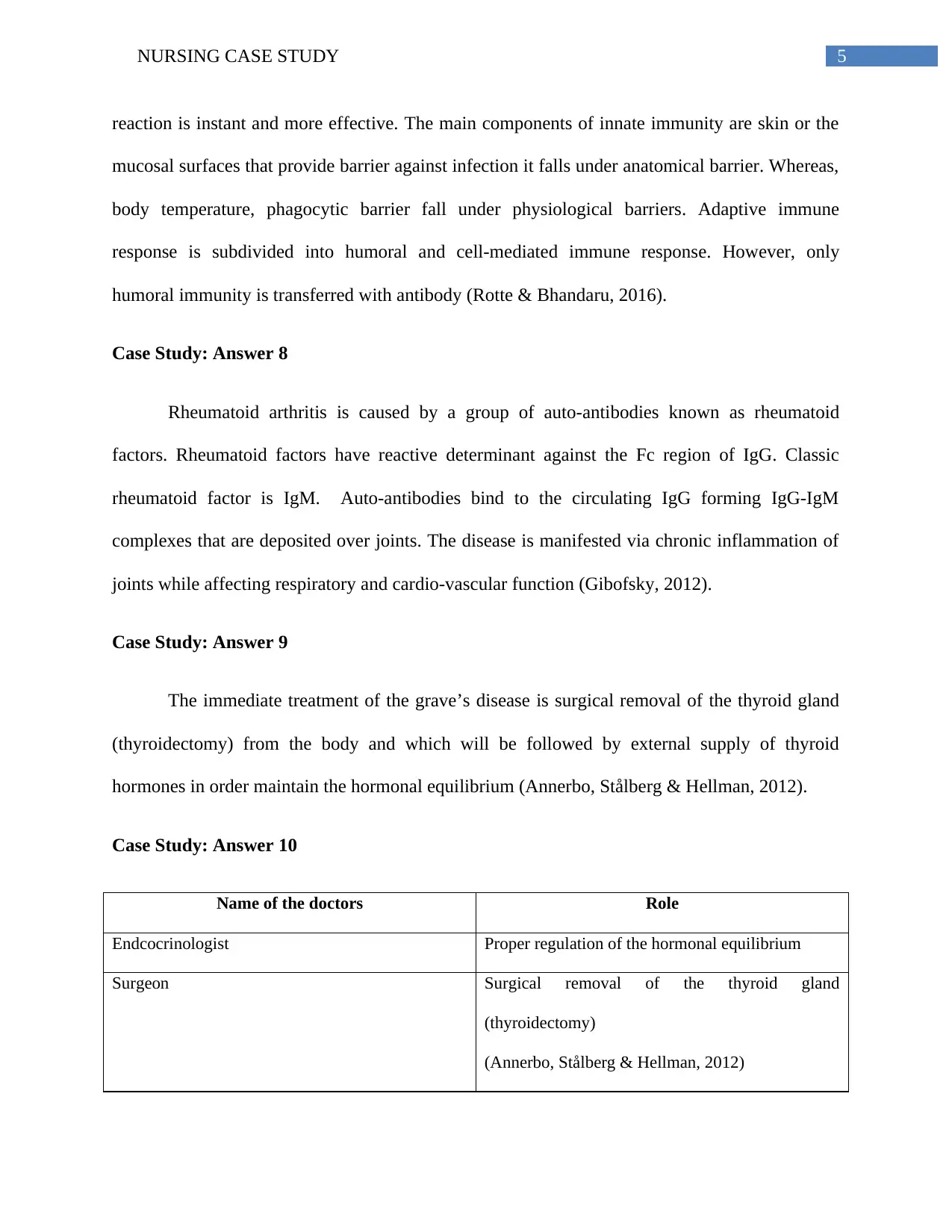
5NURSING CASE STUDY
reaction is instant and more effective. The main components of innate immunity are skin or the
mucosal surfaces that provide barrier against infection it falls under anatomical barrier. Whereas,
body temperature, phagocytic barrier fall under physiological barriers. Adaptive immune
response is subdivided into humoral and cell-mediated immune response. However, only
humoral immunity is transferred with antibody (Rotte & Bhandaru, 2016).
Case Study: Answer 8
Rheumatoid arthritis is caused by a group of auto-antibodies known as rheumatoid
factors. Rheumatoid factors have reactive determinant against the Fc region of IgG. Classic
rheumatoid factor is IgM. Auto-antibodies bind to the circulating IgG forming IgG-IgM
complexes that are deposited over joints. The disease is manifested via chronic inflammation of
joints while affecting respiratory and cardio-vascular function (Gibofsky, 2012).
Case Study: Answer 9
The immediate treatment of the grave’s disease is surgical removal of the thyroid gland
(thyroidectomy) from the body and which will be followed by external supply of thyroid
hormones in order maintain the hormonal equilibrium (Annerbo, Stålberg & Hellman, 2012).
Case Study: Answer 10
Name of the doctors Role
Endcocrinologist Proper regulation of the hormonal equilibrium
Surgeon Surgical removal of the thyroid gland
(thyroidectomy)
(Annerbo, Stålberg & Hellman, 2012)
reaction is instant and more effective. The main components of innate immunity are skin or the
mucosal surfaces that provide barrier against infection it falls under anatomical barrier. Whereas,
body temperature, phagocytic barrier fall under physiological barriers. Adaptive immune
response is subdivided into humoral and cell-mediated immune response. However, only
humoral immunity is transferred with antibody (Rotte & Bhandaru, 2016).
Case Study: Answer 8
Rheumatoid arthritis is caused by a group of auto-antibodies known as rheumatoid
factors. Rheumatoid factors have reactive determinant against the Fc region of IgG. Classic
rheumatoid factor is IgM. Auto-antibodies bind to the circulating IgG forming IgG-IgM
complexes that are deposited over joints. The disease is manifested via chronic inflammation of
joints while affecting respiratory and cardio-vascular function (Gibofsky, 2012).
Case Study: Answer 9
The immediate treatment of the grave’s disease is surgical removal of the thyroid gland
(thyroidectomy) from the body and which will be followed by external supply of thyroid
hormones in order maintain the hormonal equilibrium (Annerbo, Stålberg & Hellman, 2012).
Case Study: Answer 10
Name of the doctors Role
Endcocrinologist Proper regulation of the hormonal equilibrium
Surgeon Surgical removal of the thyroid gland
(thyroidectomy)
(Annerbo, Stålberg & Hellman, 2012)
⊘ This is a preview!⊘
Do you want full access?
Subscribe today to unlock all pages.

Trusted by 1+ million students worldwide

6NURSING CASE STUDY
Paraphrase This Document
Need a fresh take? Get an instant paraphrase of this document with our AI Paraphraser
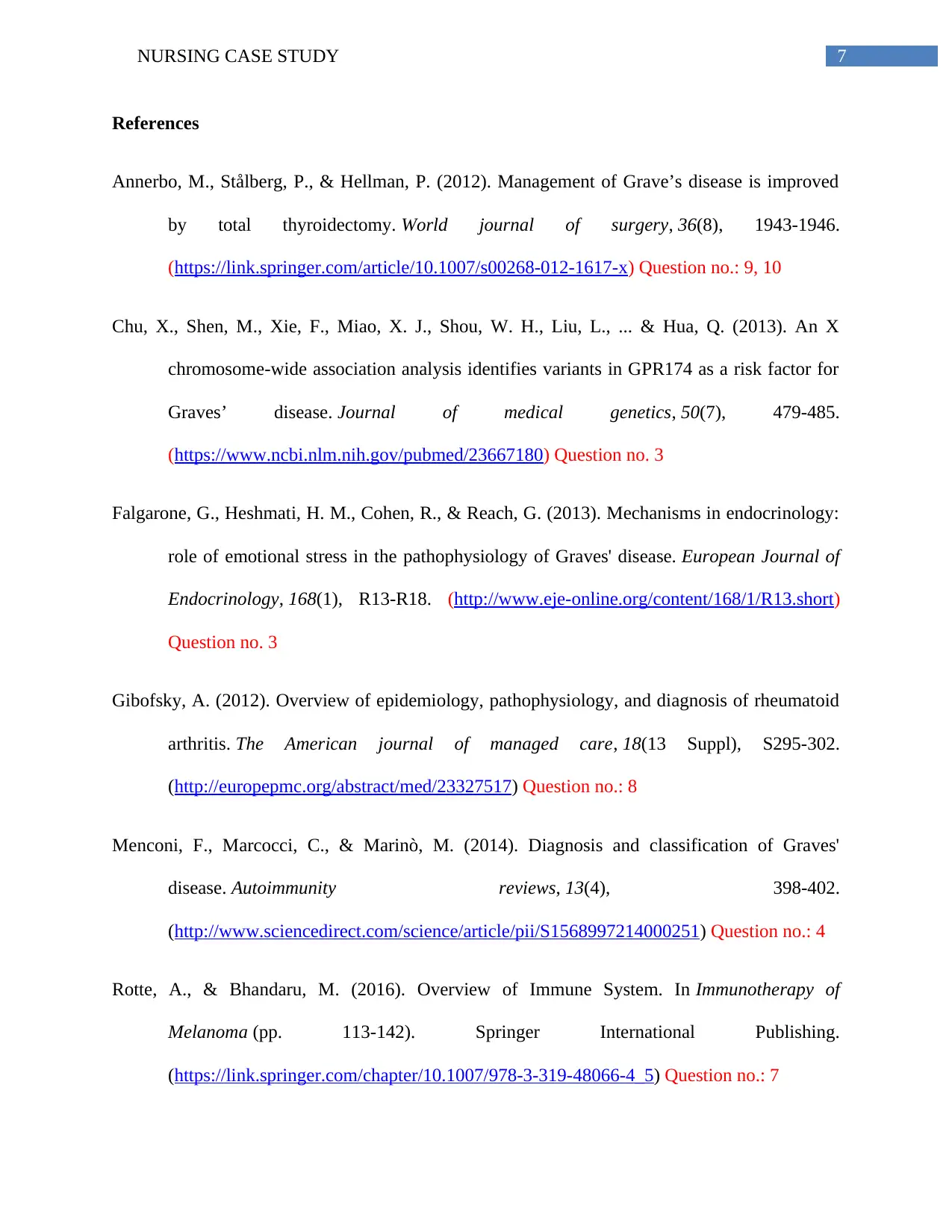
7NURSING CASE STUDY
References
Annerbo, M., Stålberg, P., & Hellman, P. (2012). Management of Grave’s disease is improved
by total thyroidectomy. World journal of surgery, 36(8), 1943-1946.
(https://link.springer.com/article/10.1007/s00268-012-1617-x) Question no.: 9, 10
Chu, X., Shen, M., Xie, F., Miao, X. J., Shou, W. H., Liu, L., ... & Hua, Q. (2013). An X
chromosome-wide association analysis identifies variants in GPR174 as a risk factor for
Graves’ disease. Journal of medical genetics, 50(7), 479-485.
(https://www.ncbi.nlm.nih.gov/pubmed/23667180) Question no. 3
Falgarone, G., Heshmati, H. M., Cohen, R., & Reach, G. (2013). Mechanisms in endocrinology:
role of emotional stress in the pathophysiology of Graves' disease. European Journal of
Endocrinology, 168(1), R13-R18. (http://www.eje-online.org/content/168/1/R13.short)
Question no. 3
Gibofsky, A. (2012). Overview of epidemiology, pathophysiology, and diagnosis of rheumatoid
arthritis. The American journal of managed care, 18(13 Suppl), S295-302.
(http://europepmc.org/abstract/med/23327517) Question no.: 8
Menconi, F., Marcocci, C., & Marinò, M. (2014). Diagnosis and classification of Graves'
disease. Autoimmunity reviews, 13(4), 398-402.
(http://www.sciencedirect.com/science/article/pii/S1568997214000251) Question no.: 4
Rotte, A., & Bhandaru, M. (2016). Overview of Immune System. In Immunotherapy of
Melanoma (pp. 113-142). Springer International Publishing.
(https://link.springer.com/chapter/10.1007/978-3-319-48066-4_5) Question no.: 7
References
Annerbo, M., Stålberg, P., & Hellman, P. (2012). Management of Grave’s disease is improved
by total thyroidectomy. World journal of surgery, 36(8), 1943-1946.
(https://link.springer.com/article/10.1007/s00268-012-1617-x) Question no.: 9, 10
Chu, X., Shen, M., Xie, F., Miao, X. J., Shou, W. H., Liu, L., ... & Hua, Q. (2013). An X
chromosome-wide association analysis identifies variants in GPR174 as a risk factor for
Graves’ disease. Journal of medical genetics, 50(7), 479-485.
(https://www.ncbi.nlm.nih.gov/pubmed/23667180) Question no. 3
Falgarone, G., Heshmati, H. M., Cohen, R., & Reach, G. (2013). Mechanisms in endocrinology:
role of emotional stress in the pathophysiology of Graves' disease. European Journal of
Endocrinology, 168(1), R13-R18. (http://www.eje-online.org/content/168/1/R13.short)
Question no. 3
Gibofsky, A. (2012). Overview of epidemiology, pathophysiology, and diagnosis of rheumatoid
arthritis. The American journal of managed care, 18(13 Suppl), S295-302.
(http://europepmc.org/abstract/med/23327517) Question no.: 8
Menconi, F., Marcocci, C., & Marinò, M. (2014). Diagnosis and classification of Graves'
disease. Autoimmunity reviews, 13(4), 398-402.
(http://www.sciencedirect.com/science/article/pii/S1568997214000251) Question no.: 4
Rotte, A., & Bhandaru, M. (2016). Overview of Immune System. In Immunotherapy of
Melanoma (pp. 113-142). Springer International Publishing.
(https://link.springer.com/chapter/10.1007/978-3-319-48066-4_5) Question no.: 7
1 out of 8
Related Documents
Your All-in-One AI-Powered Toolkit for Academic Success.
+13062052269
info@desklib.com
Available 24*7 on WhatsApp / Email
![[object Object]](/_next/static/media/star-bottom.7253800d.svg)
Unlock your academic potential
Copyright © 2020–2025 A2Z Services. All Rights Reserved. Developed and managed by ZUCOL.





